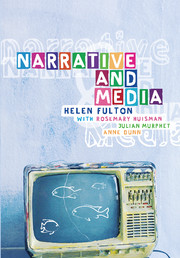Book contents
- Frontmatter
- Contents
- Figures and tables
- Contributors
- Acknowledgements
- 1 Introduction: the power of narrative
- Part 1 The basics of narrative theory
- Part 2 Film as narrative and visual mode
- Part 3 Television: narratives and ideology
- Part 4 Radio and print journalism
- 14 Structures of radio drama
- 15 Radio news and interviews
- 16 Print news as narrative
- 17 Analysing the discourse of news
- Part 5 Popular print culture
- Glossary
- Bibliography
- Index
14 - Structures of radio drama
Published online by Cambridge University Press: 05 June 2012
- Frontmatter
- Contents
- Figures and tables
- Contributors
- Acknowledgements
- 1 Introduction: the power of narrative
- Part 1 The basics of narrative theory
- Part 2 Film as narrative and visual mode
- Part 3 Television: narratives and ideology
- Part 4 Radio and print journalism
- 14 Structures of radio drama
- 15 Radio news and interviews
- 16 Print news as narrative
- 17 Analysing the discourse of news
- Part 5 Popular print culture
- Glossary
- Bibliography
- Index
Summary
The history of radio drama is to a large extent a history of theorising the radio medium; it charts the discovery of the nature of radio and its relationship to the listener. Radio plays began as plays on radio. In the early days of radio, few writers thought to write specifically for radio. It was considered a good medium on which to broadcast plays written for the theatre; its distinguishing feature, the absence of the visual dimension, was not considered a problem. Plays are, after all, a literary form, and the canon of classical drama was prized for its language, its use of words, rather than for what you could see happening on stage. Andrew Crisell, who has written extensively about radio (1994, 1997, 2000), has pointed out that until the sixteenth century at least people spoke of ‘hearing’ a play rather than seeing it, reflecting the relationship of drama to poetry in rhythm and rhyme. There are examples of this usage in Shakespeare's plays: Hamlet says, ‘Follow him friends; we'll hear a play tomorrow.’ The word ‘audience’ is derived from the Latin ‘audire’, to hear.
Crisell (2000) attributes an increased concentration on visual effects in theatre to the development over time of new staging technology – such as perspective in scenery at the end of the seventeenth century – and artistic innovations, such as the elaborate machinery, spectacular sets and costumes of the Paris Opera of the early eighteenth century.
- Type
- Chapter
- Information
- Narrative and Media , pp. 191 - 202Publisher: Cambridge University PressPrint publication year: 2005



